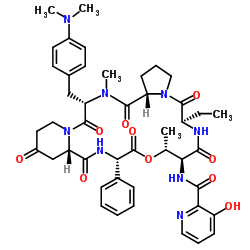270076-60-3
| Name | Pristinamycin |
|---|---|
| Synonyms |
Pristinamycin IA
Vernamycin B α MFCD01778146 2-Pyridinecarboxamide, N-[(6R,9S,10R,13S,15aS,22S,24aS)-22-[[4-(dimethylamino)phenyl]methyl]-6-ethyldocosahydro-10,23-dimethyl-5,8,12,15,17,21,24-heptaoxo-13-phenyl-12H-pyrido[2,1-f]pyrrolo[2,1-l][1,4,7,10,13,16]oxapentaazacyclononadecin-9-yl]-3-hydroxy- N-{(6R,9S,10R,13S,15aS,22S,24aS)-22-[4-(Dimethylamino)benzyl]-6-ethyl-10,23-dimethyl-5,8,12,15,17,21,24-heptaoxo-13-phenyldocosahydro-12H-pyrido[2,1-f]pyrrolo[2,1-l][1,4,7,10,13,16]oxapentaazacyclononadecin-9-yl}-3-hydroxy-2-pyridinecarboxamide Ostreogrycin B Streptogramin B |
| Description | Pristinamycin, produced by Streptomyces pristinaespiralis, is an orally active streptogramin-like antibiotic consisting of two chemically unrelated components: Pristinamycin I (PI) and Pristinamycin II (PII). Pristinamycin is highly active against many antibiotic-resistant pathogens, particularly Gram-positive bacteria, including Methicillin-resistant Staphylococcus aureus (MRSA), Vancomycin-resistant S. aureus (VRSA) and Enterococcus faecium (VREF)[1]. |
|---|---|
| Related Catalog | |
| In Vitro | In-vitro studies show pristinamycin to inhibit Staphylococci and Streptococci, including Erythromycin highly-resistant organisms, at a concentration of less than or equal to 0.78 mg/l[2]. |
| In Vivo | To study Pristinamycin activity in vivo, mice infected IP with C. psittaci. Mortality in the control group was 70%. Three groups of mice received 25 mg/kg, 50 mg/kg and 100 mg/kg Pristinamycin respectively. The antibiotic was active in the 100 mg/kg dosage which is the therapeutic dosage[3]. |
| References |
| Density | 1.4±0.1 g/cm3 |
|---|---|
| Boiling Point | 1202.1±65.0 °C at 760 mmHg |
| Molecular Formula | C73H89N11O17 |
| Molecular Weight | 866.958 |
| Flash Point | 680.8±34.3 °C |
| Exact Mass | 866.396301 |
| LogP | -0.45 |
| Vapour Pressure | 0.0±0.3 mmHg at 25°C |
| Index of Refraction | 1.650 |
